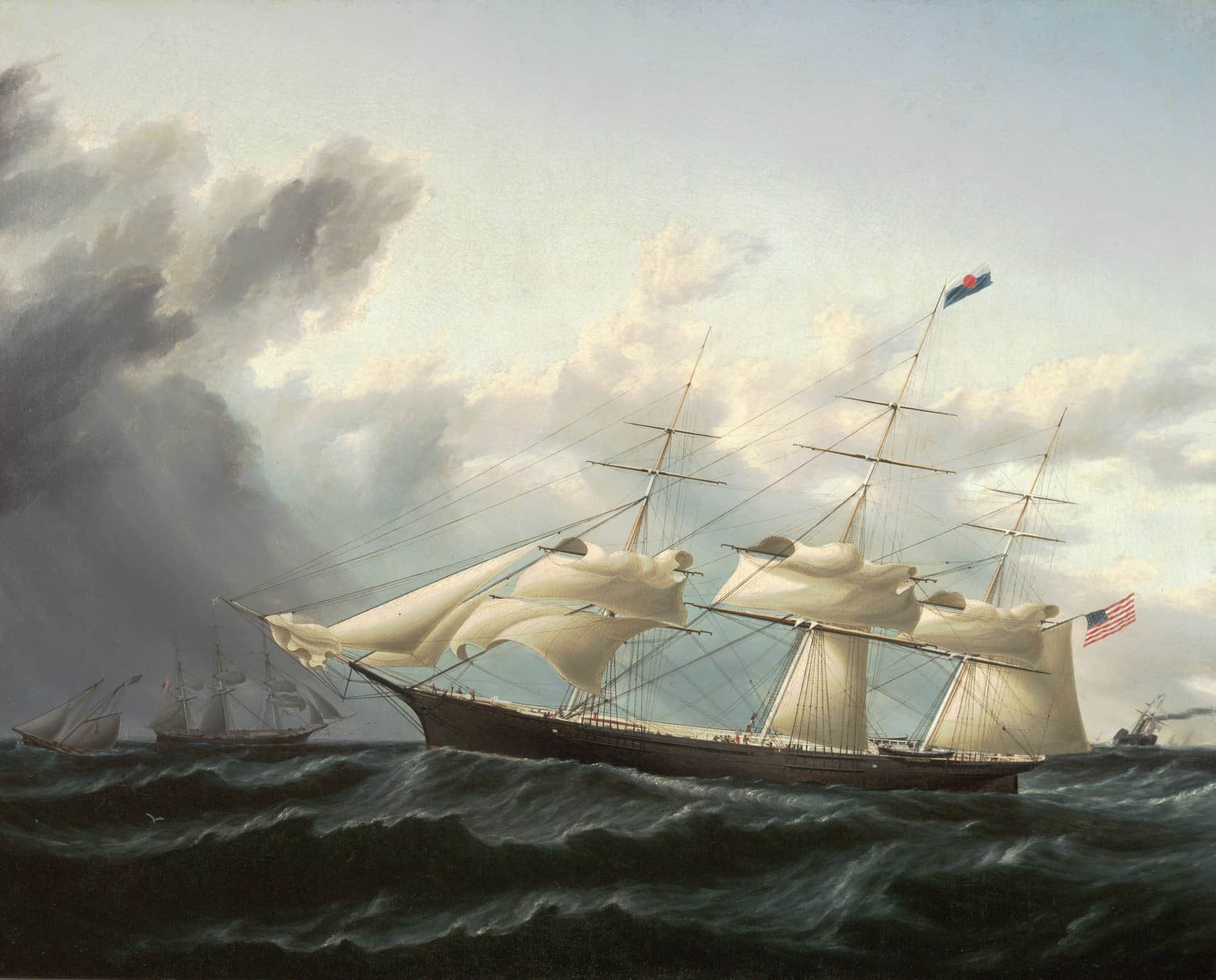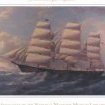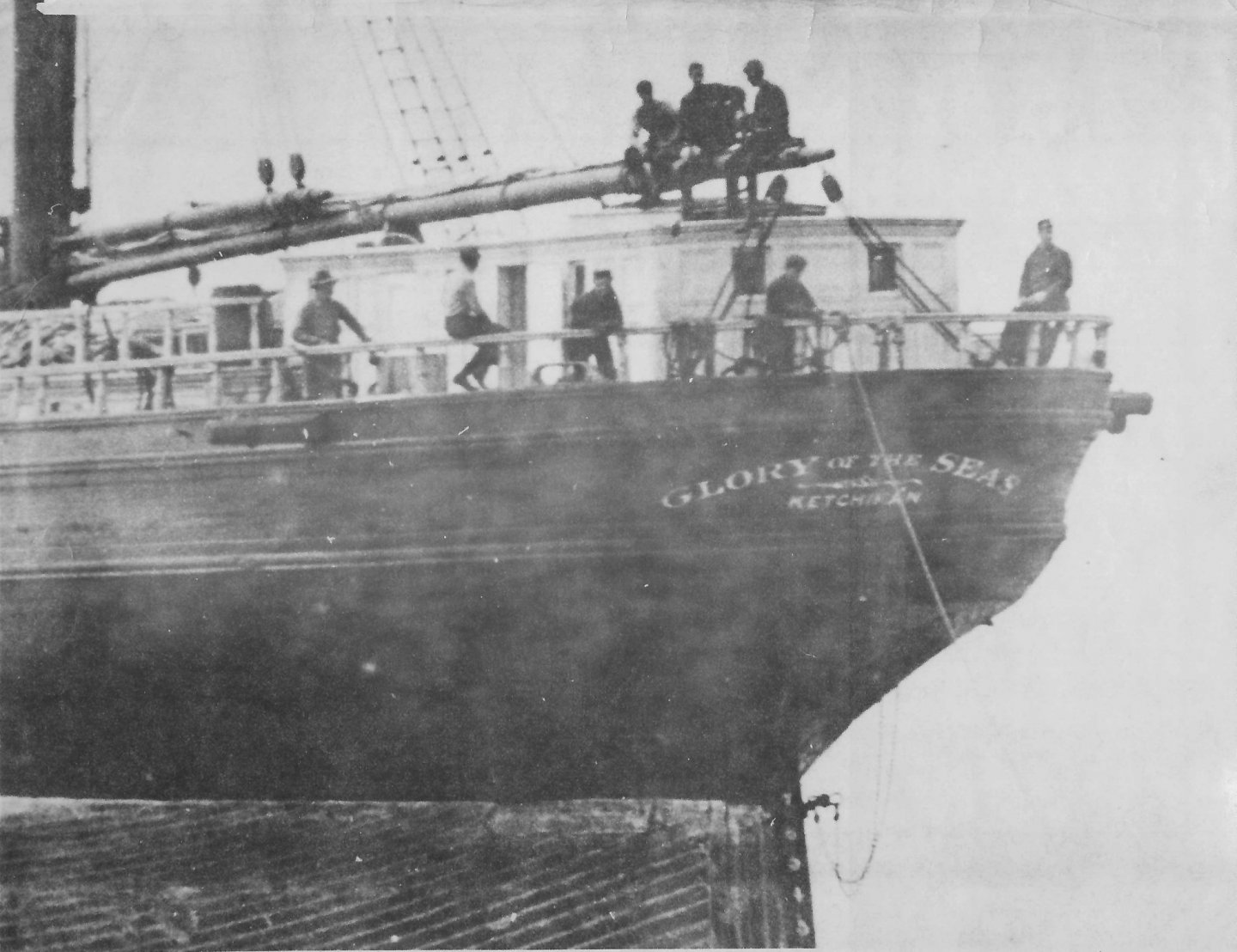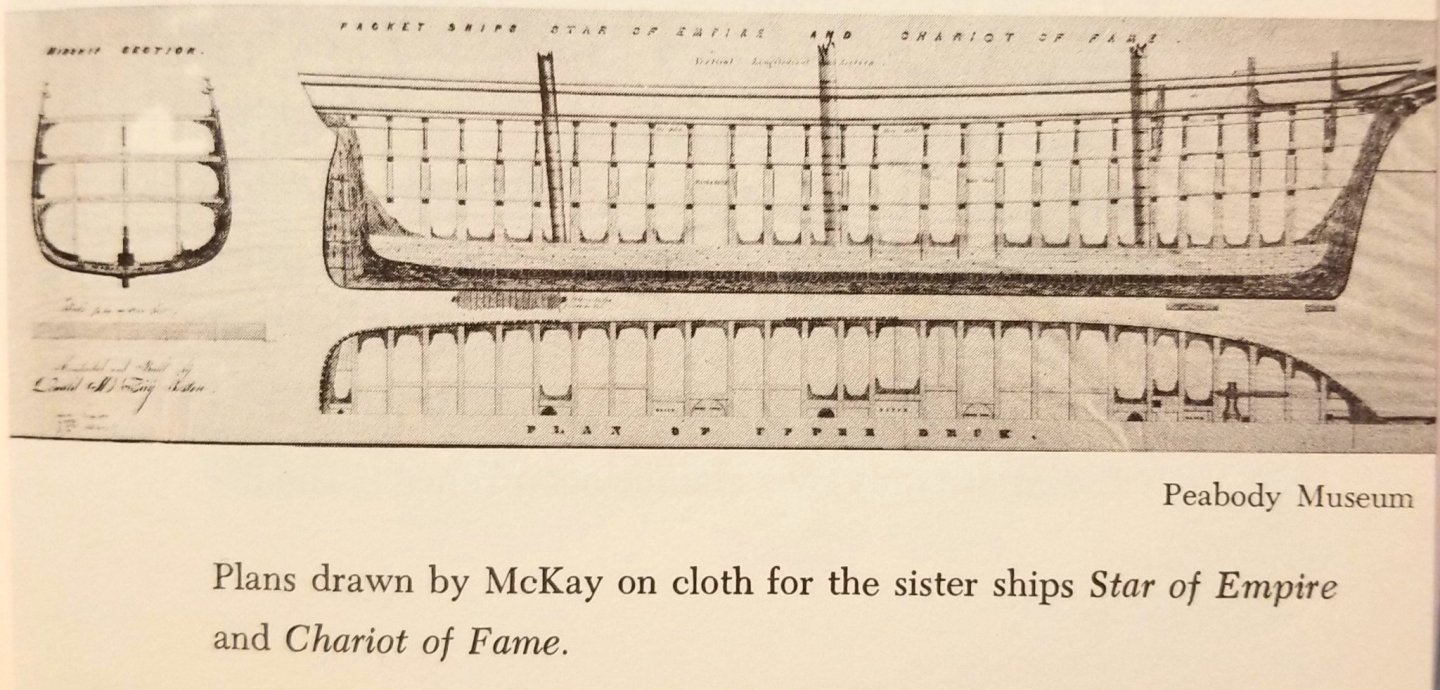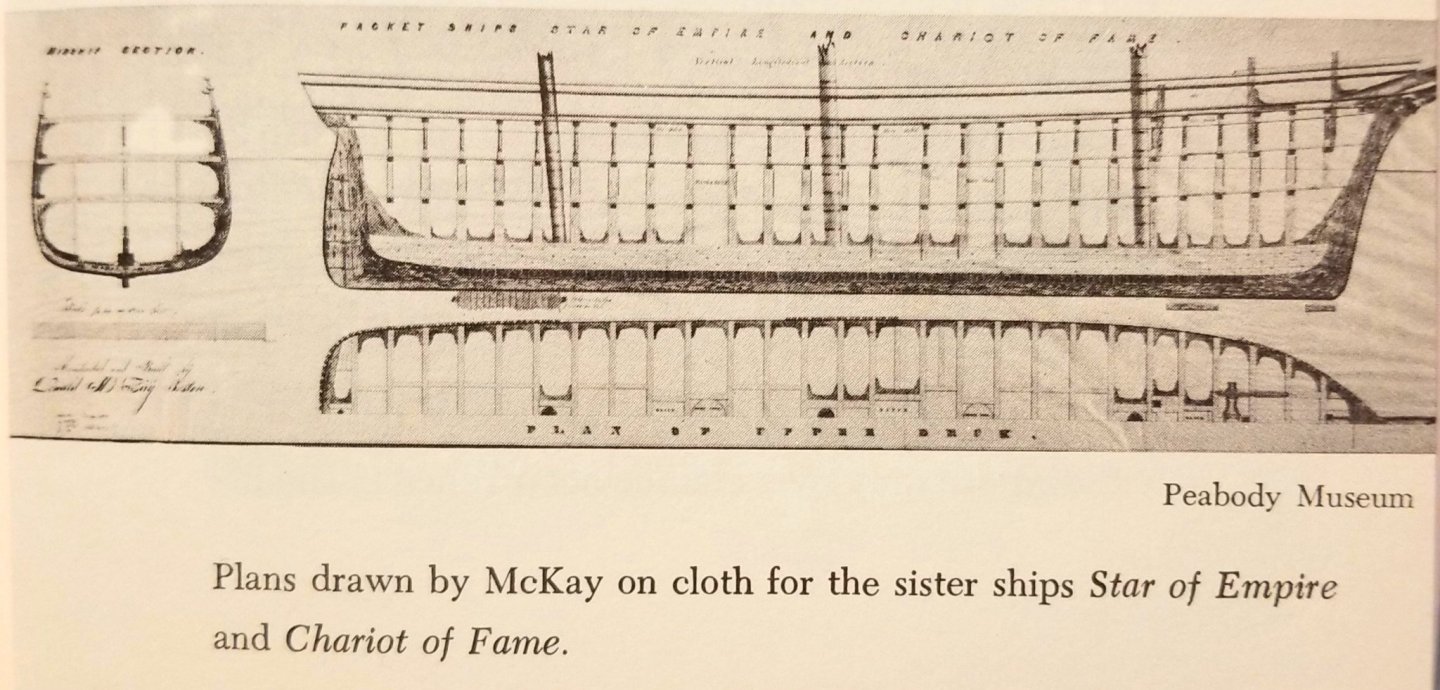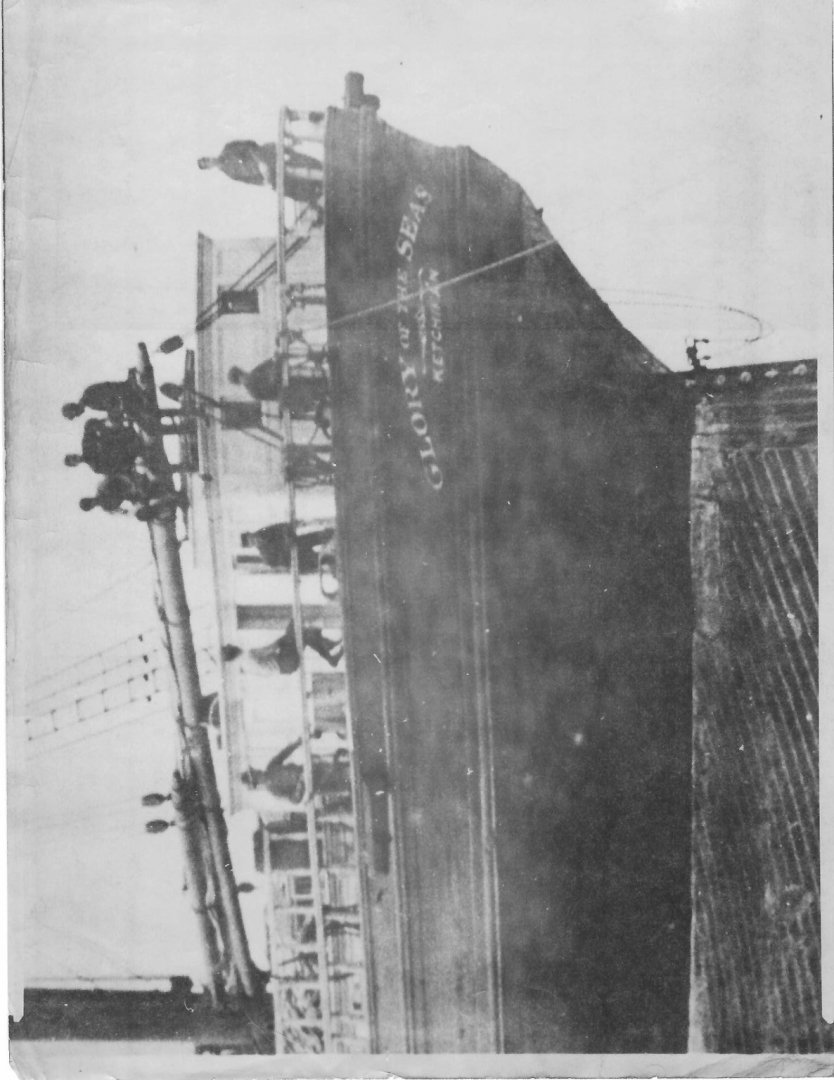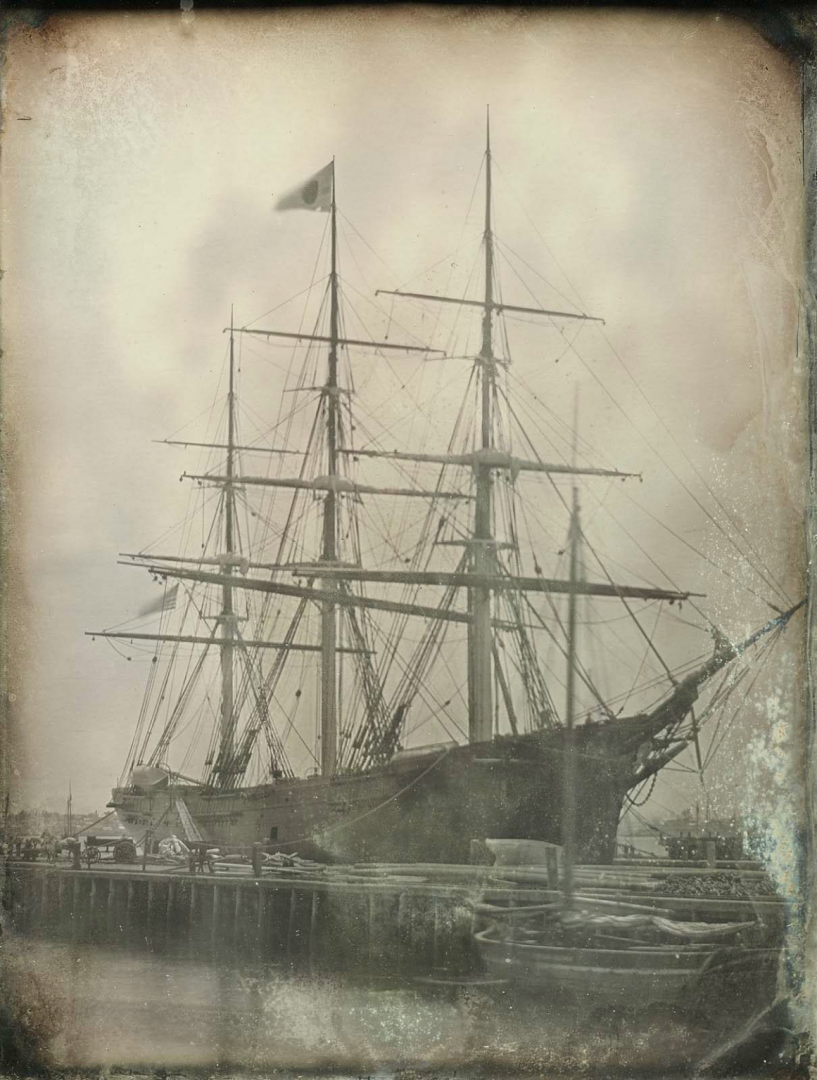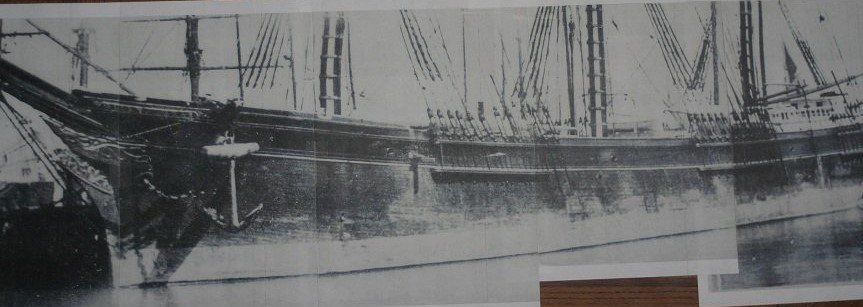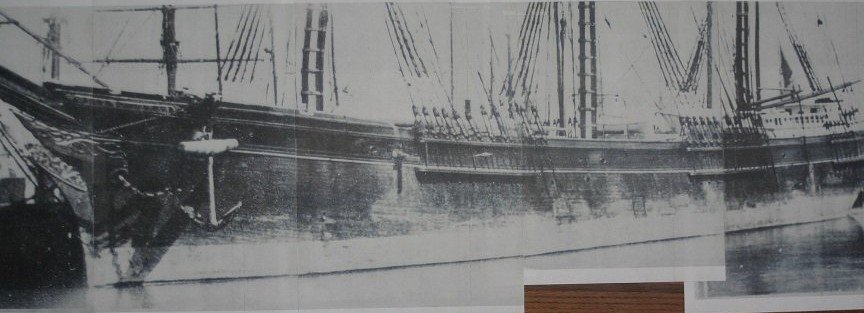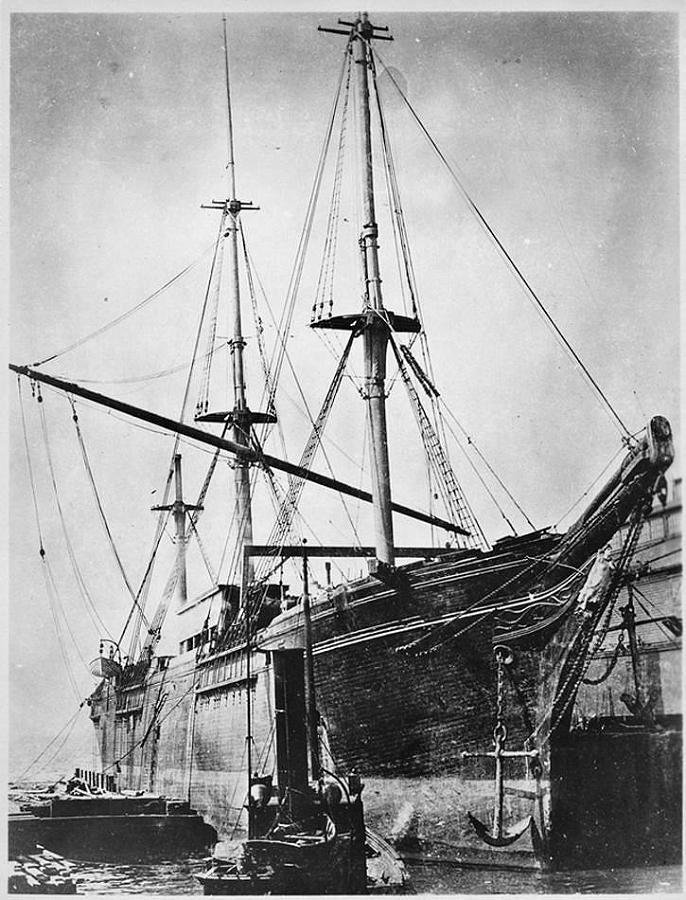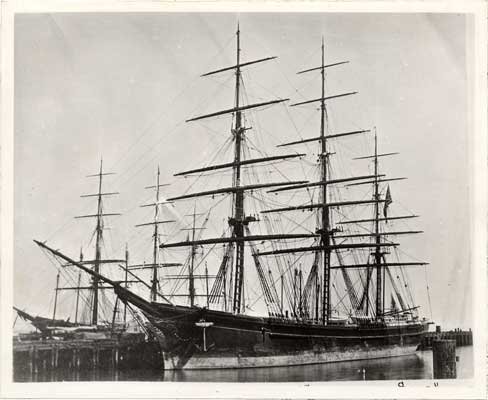-
Posts
2,152 -
Joined
-
Last visited
Content Type
Profiles
Forums
Gallery
Events
Everything posted by ClipperFan
-
Happy Easter, guys Being still dissatisfied with our severely verticle Bow, I decided to evaluate the Bows of McKay's previous Clippers for comparison. The results I found are intriguing and make a compelling argument for a more angled Bow than we currently have. 1869 "Glory of the Seas" Keel 240' Length on deck 250' Length overall (LOA) 265' Ratio: keel to deck .96 Ratio: keel to LOA .905 1850 Extreme Clipper "Staghound" Keel 207' Length on deck 215' Length overall 226' Ratio: keel to deck .96 Ratio: keel to LOA .915 1851 Extreme Clipper "Flying Cloud" Keel 208' Length on deck 225' Length overall 235' Ratio: keel to deck .92 Ratio: keel to LOA .89 I will add more results & images to support my theory a little later
- 3,560 replies
-
- clipper
- hull model
-
(and 2 more)
Tagged with:
-
Rob, somehow I missed this comment until now. Honestly, with each phenomenal, crystal clear image Michael Mjelde sends us, our comprehension of McKay's last Clipper comes more clearly into view. With your clarification of her bulwark heights, I think that can finally be nailed down to. It hadn't occurred to me that measured from inside, her Bulwarks are 6 1/2' but from outside, since her sheerline molding aligns at the top of the 1' waterways, they will naturally appear 15" shorter (3" for deck and 12" for waterways). If I remember correctly, those moldings were 7" which would bring that external drop to 8". So if we go 8" below the lowest sheerline molding, that would be the base of the 5' main rail bulkhead, to which would be added 18" monkeyrail with cap. As a result a 6 1/2 bulkhead would appear to be 5' 10". Am I finally getting it?
- 3,560 replies
-
- clipper
- hull model
-
(and 2 more)
Tagged with:
-
Vladimir, Rob Referring to post #691, I have added 2 images to highlight 2 continuing concerns I have about Glory's hull evolution. I think Vladimir is about 90% there. Instead of referring to measurements, I'll resort to relationships instead. Look closely at the Stern section drop it's all little deeper than what Vladimir has now. It appears to fit neatly into the area of the main rail between 2 short shelfs under and above the moldings. A thin line, just below main rail moldings can be seen on the McKay Hull sketch. It goes across the entire hull and seems to align perfectly with the bottom of the Naval Hoods. Rob has determined Hood depth to be 3 1/2'. My other bigger concern is with Glory's cutwater and stem which I strongly feel would be far more likely to match that of the McKay sketch too. That's the impression I get especially after seeing a more clear overall image of her Bow in Seattle. The curve of her Cutwater continues down thru both Bobstay mounts and then follows down at an angle.
- 3,560 replies
-
- clipper
- hull model
-
(and 2 more)
Tagged with:
-
- 3,560 replies
-
- clipper
- hull model
-
(and 2 more)
Tagged with:
-
Rob, These scenes are much lighter than what I've seen before, details are much better defined. I'm continually in awe of the very substantial construction of "Glory of the Seas" in every item. What also surprises me is how seeing rugged construction, so much more substantial than Duncan MacLean's somewhat simple description, helps me to perceive the intent of her designer. Glory's waterways for instance are described as being 12" square, yet this photo shows them being rounded along sides and top, which makes far more sense in a nautical vessel where hard edges could cause serious injuries. The total loss of such a magnificent vessel weighs heavily on me too. She was so well built. If only her successive owners had the foresight to maintain her yellow metal hull, they would have kept the damn toredo worm and successive rot at bay.... Had they done that, she surely could have made one final journey around Cape Horn to her home in Boston and we would have been able to see her proudly afloat today....
- 3,560 replies
-
- clipper
- hull model
-
(and 2 more)
Tagged with:
-
Rob, For sake of accuracy, it's beginning to appear like the best approach is to rebuild her from the inside out, starting from her keel upwards. The one area that gives me the most confidence in her exterior dimensions is at her docking ports. I counted 9 1/2 planks from waterline to bottom of the port, 4 to make the side and 7 up to the lower sheerline molding. Now knowing that the upper sheerline molding is bolted to the top of the 12" waterways on the main deck, which is 3" above main deck line, if we measure 5' up from that 15" drop we get her main rail height, then add 18" to top of that for a total of 6 1/2'. We know her 2 lower decks are 8'2" height, presumably above more 3" decks. She's described as having a 28 1/2 hold, with 22' coppered from false keel to her waterline. She should be coming along nicely.
- 3,560 replies
-
- clipper
- hull model
-
(and 2 more)
Tagged with:
-
- 3,560 replies
-
- clipper
- hull model
-
(and 2 more)
Tagged with:
-
Vladimir, I expressed your appreciation to Mike who's being so generous with these fantastic images which likely haven't been seen in decades. I was so impressed that I sent Mike a request for the rest of the vessel in this scene. Meanwhile, the stern shows that the turned rails aren't verticle. They cant outwards almost imperceptibly around the stern, appear to be most verticle along the Wheelhouse section and then cant inwards around the large Stern house. The monkeyrail below also appears to do the same. The main rail drop almost appears to Bow inward but it looks to me like it's an affect of the short shelf like area combined with double planksheer moldings. Most fascinating is the 3' - 4' area below which ends in a slight ridge. While it gave an initial appearance of being solely around her Stern, I now suspect it encircles the entire vessel but is far less noticable. In fact, it looks like it aligns perfectly with the lower end of the Naval Hoods. What surprised me was that this same feature can be seen on McKay's illustration of sister Packet ships "Star of Empire" & "Chariot of Fame" as seen here. Finally as first suspected, the graceful drop below this line curves slightly inwards as it drops to the rudder. In totality, this area of Glory is far more complex than first suspected.
- 3,560 replies
-
- clipper
- hull model
-
(and 2 more)
Tagged with:
-
Rob, To summarize, upper main deck waterways were 1' square per the description in the 1869 newspaper article. Since they're above the 3" thick deck planks, they're actually 15" and that would be the same exterior location of the plank sheer moldings. So while the interior bulkhead was 6 1/2' (5 main rail height & 18" monkeyrail) exterior main rail would look 15" shorter than 5' making it appear externally as if it was 3' 9" with an 18" monkey rail above for a total apparent exterior height of 5'3" does that sound right? Or would added moldings bring it up to 6' on the exterior? I'm still trying to nail down the accurate dimensions to ensure how "Glory of the Seas" hull would look. I get the sense we're very close now. Your description of the internal construction was very helpful. The only other confusing discrepancy is MacLean's description of Glory's bulkheads being 6'. I almost wonder if he's expecting his readers to know he wasn't including moldings and cap rail dimensions in that statistic.
- 3,560 replies
-
- clipper
- hull model
-
(and 2 more)
Tagged with:
-
Rob, I borrowed your idea and matched 2 of your images to make a final one that shows "Glory of the Seas" completely from Bow to Stern.
- 3,560 replies
-
- clipper
- hull model
-
(and 2 more)
Tagged with:
-
Rob & Vladimir, I asked Mike for a better look at Glory's stern from the scene of her being towed to Alaska. Here's his original, facing down and a cropped version facing up. As I first noticed, her Stern is far more elegant and complex than earlier suspected. Her turned Rail stanchions, while appearing almost verticle seem to cant just slightly outward, as does the monkeyrail below, then her main rail looks like it bows slightly inward but I suspect it's due to the effect of her moldings. The area below that appears to bow out slightly. Rob can measure it. My best guess is about a 3 - 4 drop. Finally the rest of the Stern curves again just slightly inward as it drops gracefully to the rudder below. Far more complex than at first glance.
- 3,560 replies
-
- clipper
- hull model
-
(and 2 more)
Tagged with:
-
Rob, for the purpose of consistency, I'd say it's fairly safe to conclude that from the exterior, from the lowest sheer rail molding to the top of the main rail molding is 5' and from there to the top of the monkeyrail molding is an additional 18" for a consistent exterior bulwark height of 6 1/2'.
- 3,560 replies
-
- clipper
- hull model
-
(and 2 more)
Tagged with:
-
Rob, this particular vaguary has always troubled me. If the main rail and monkeyrail combined are described as being 6' yet visually bulwarks appear higher, then I'd say the moldings on top of the main rail and monkeyrail are not being counted. Adding them in would probably bring total bulwark height from deck to top of monkeyrail molding to 6 1/2'. Again, referring to earlier 1869 on the ways or even the 1877 scene, is there a reliable way to get an actual measurement, to be sure?
- 3,560 replies
-
- clipper
- hull model
-
(and 2 more)
Tagged with:
-
Vladimir, you're welcome for the picture. Rob has more accurate numbers than mine. He said from peak of cap rail to center of 1st notch is 9' from there to center of 2nd notch is 6' and 4' more to cathead center, for a total of 19'. One foot further than my guesstimate. Rob refers to the main rail & monkey rail being 6' high but I think he's not counting various moldings, which when you combine a 3 of those would put it at 6 1/2'.
- 3,560 replies
-
- clipper
- hull model
-
(and 2 more)
Tagged with:
-
Here's the 1854 Black Ball Clipper "Champion of the Seas" at the time she was launched, she was the largest Merchant ship in the world. She was 2,447 tons, 238' keel. 252' on deck between perpendiculars. Since her stern post was verticle, her stem projected out 14'. From this contemporary daguerrotype, you'd be hard pressed to believe that. While Glory's sheer was 7' this vessel's was a much more modest 4 1/2'. Glory was very similar in dimensions, being 250' between perpendiculars on deck but was significantly smaller at 2102 tons. There's a very detailed description of Champion from the May 20, 1854 Boston Daily Atlas, on Lars Bruzelius' site. As for Glory's Bow I'm now much more inclined to believe she looked very similar to the "Henry B Hyde" but with less dramatic sheer.
- 3,560 replies
-
- clipper
- hull model
-
(and 2 more)
Tagged with:
-
Rob, My "eyeball" guesstimate was 18'. If I read your calculations correctly, I was off by 1'. 9' from point above Jibboom to center of 1st notch, 6' from center of 1st to 2nd notch and 4' to cathead center, equaling 19' in total. I'm still wondering about her bulwark height though. Has the damaged Bulwark brought your estimate down. I've read most of McKay's Clippers had 5' Main Rails, typically topped by 18" monkey rail for a total of 6 1/2'. Mike said he spoke with crew who were 6' tall and served on Glory. They told him standing by the bulwark, they could not see over the top. That's what leads me to believe her Bulwarks were over 6'. Your thoughts?
- 3,560 replies
-
- clipper
- hull model
-
(and 2 more)
Tagged with:
-
Rob, I edited out the extraneous details and sent these 3 images to Michael Mjelde. He said you did a great job combining these into one picture. He eventually plans to send the overall 1877 scene. I also requested the picture of Glory being towed to Alaska in order to get a more clear view of her fascinating stern.
- 3,560 replies
-
- clipper
- hull model
-
(and 2 more)
Tagged with:
-
Vladimir, Probably the only picture of Glory which reveals the true location of her anchor stock catheads and gives an accurate idea of their dimensions. They're located completely under her fore quarterdeck caprail. They fit entirely within her 18" high monkeyrail. Cathead width can be calculated by comparing it to height, my best estimate is 8-9". Distance from first notch to second notch looks to be 5' and about 4' to the cathead. That would make the cathead's distance about 18' from the point of the quarterdeck caprail where they join just above the Jibboom entrance. As usual, Rob can double check and either verify or adjust my estimates.
- 3,560 replies
-
- clipper
- hull model
-
(and 2 more)
Tagged with:
-
Vladimir, Druxey's revised figurehead will fit right in. All he did was revise Athene's right hand to match contours of her hand and upper shoulder. One final observation of the Naval Hood. Three equal moldings trim the bottom while two continue from the Hull to trim the upper side. The three below terminate at the outer end the two above go completely around to the other side.
- 3,560 replies
-
- clipper
- hull model
-
(and 2 more)
Tagged with:
-
Vladimir, You always do such nice clean work. I am continually impressed. My only critique is that the fat, leading edge is not verticle. It inclines at a slight degree forward, to follow contours of Glory's flaring Hull. Top of the leading edge appears to align directly with the left side of the notch above while botton appears to line up with the center of that same forward, 1st notch. My tracing pad finally arrived, so I will make so tracings of Glory to be exhaustively precise.
- 3,560 replies
-
- clipper
- hull model
-
(and 2 more)
Tagged with:
-
Druxey, My suggestion to Vladimir was to replace your older Athene with the more refined version in post #643. About the best tracing of Mike's excellent extra sharp closeup in post #547, is the center image in post #564. However, the section above the anchor hawse hole cants inward, not exactly verticle. I refer to a line that exits the first notch, crosses over the "E" in SEAS and perfectly outlines that leading edge of the Naval Hood. Look very closely, the triple moldings at the lower edge of her Naval Hood aren't verticle either. They each are a little shorter than the one below, aligning with that beveled edge.
- 3,560 replies
-
- clipper
- hull model
-
(and 2 more)
Tagged with:
-
Sailor, I sympathize with your verklempft reaction to pictures I share from Michael Mjelde. It's as if they're being transmitted from OZ (Downunder, not the Emerald City)! Try as I might and believe me I've made multiple attempts, images that arrive in my email stubbornly remain upside down. I figure the group would prefer to receive these glorious highly detailed prints upside down than not at all. Mike has told me made these images directly from original negatives of over 40 years ago. Since my own printer hasn't worked for years I've been going to Staples. For 15c a standard page, I've emailed them directly to: staples@printme.com where I've been able to make my own copies. You can print Legal 16c up to Ledger size 24c. They even offer beautiful color too: Standard 55c, Ledger .90c
- 3,560 replies
-
- clipper
- hull model
-
(and 2 more)
Tagged with:
-
Rob, A few posts back I shared a page which confirms Glory's sheer was indeed seven feet. From this beautiful 1877 Glory docked at San Francisco scene, her lovely sheer is clearly evident. This is the same image that reveals her impressively lofty rig as well. I agree with Sailor, please share your stitched together scene with our group.
- 3,560 replies
-
- clipper
- hull model
-
(and 2 more)
Tagged with:
-
Rob, If you look at the more assertive profile of the "Donald McKay" I believe it will help us reassess "Glory of the Seas" more accurately while dispelling perspective bias clouding our perceptions. I'm not saying her entrance was as aggressive as the "M'Kay" but it does appear her profile below the waterline was inclined back more than our current illustrations show. As for her higher copper line, this is most likely in anticipation of heavy equipment installed to support her work as a factory salmon cannery ship.
- 3,560 replies
-
- clipper
- hull model
-
(and 2 more)
Tagged with:
-
Druxey, I just want to be sure I understand you. The profile above that I shared earlier is that of another much larger vessel the "Donald McKay" 260' between perpendiculars, 2,488 tons vs "Glory of the Seas" 250' between perpendiculars, 2,102 tons. I shared this image because its recorded as being accurate, since British took the lines off her while she was in Dry Dock. My point is that this vessel, which has a more subdued bow profile has a far less verticle entrance than what we're estimating for Glory. However, if you're referring to the 1911 Seattle refit of Glory, the smashed upper Bulwarks appear to have shoved some of her upper moldings forward, marring her appearance but not affecting her sea worthiness.
- 3,560 replies
-
- clipper
- hull model
-
(and 2 more)
Tagged with:
About us
Modelshipworld - Advancing Ship Modeling through Research
SSL Secured
Your security is important for us so this Website is SSL-Secured
NRG Mailing Address
Nautical Research Guild
237 South Lincoln Street
Westmont IL, 60559-1917
Model Ship World ® and the MSW logo are Registered Trademarks, and belong to the Nautical Research Guild (United States Patent and Trademark Office: No. 6,929,264 & No. 6,929,274, registered Dec. 20, 2022)
Helpful Links
About the NRG
If you enjoy building ship models that are historically accurate as well as beautiful, then The Nautical Research Guild (NRG) is just right for you.
The Guild is a non-profit educational organization whose mission is to “Advance Ship Modeling Through Research”. We provide support to our members in their efforts to raise the quality of their model ships.
The Nautical Research Guild has published our world-renowned quarterly magazine, The Nautical Research Journal, since 1955. The pages of the Journal are full of articles by accomplished ship modelers who show you how they create those exquisite details on their models, and by maritime historians who show you the correct details to build. The Journal is available in both print and digital editions. Go to the NRG web site (www.thenrg.org) to download a complimentary digital copy of the Journal. The NRG also publishes plan sets, books and compilations of back issues of the Journal and the former Ships in Scale and Model Ship Builder magazines.

